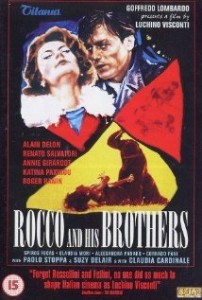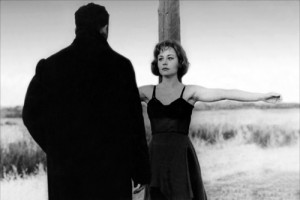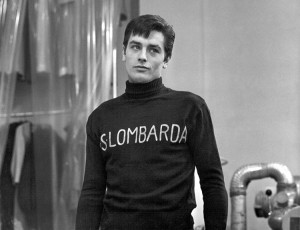 Brilliantly shot in black-and-white by the ace cinematographer Giuseppe Rotunno, the film boasts an epic running time of 177 minutes and spans a period of 12 years or so, but it’s never dull for a moment. (Beware of shorter versions, such as the one that played theatrically in the U.S. in the early 1960s).The movie unfolds as a sweepingly emotional family Greek tragedy, an involving melodrama that’s superlatively acted by the entire ensemble, headed by Greek-born Katina Paxinou (Oscar winner in 1943 for “For Whom the Bell Tolls”), heartthrob Alain Delon (at his most handsome), and French actress Annie Girardot. (Delon and Girardot would become major French stars of the 1960s and 1970s).
Brilliantly shot in black-and-white by the ace cinematographer Giuseppe Rotunno, the film boasts an epic running time of 177 minutes and spans a period of 12 years or so, but it’s never dull for a moment. (Beware of shorter versions, such as the one that played theatrically in the U.S. in the early 1960s).The movie unfolds as a sweepingly emotional family Greek tragedy, an involving melodrama that’s superlatively acted by the entire ensemble, headed by Greek-born Katina Paxinou (Oscar winner in 1943 for “For Whom the Bell Tolls”), heartthrob Alain Delon (at his most handsome), and French actress Annie Girardot. (Delon and Girardot would become major French stars of the 1960s and 1970s).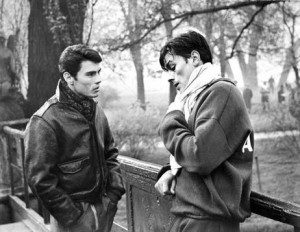 On one level, Rocco and His Brothers is sort of a follow-up to The Earth Trembles, which is considered by many scholars to be one of the first seminal Italian neo-realist films (though seen in the West years after being made). The movie deals with a major culture clash, a result of the migration of Southern Italians to Northern industrial areas, where the movie is set. As a melodrama, Rocco and His Brothers offers a wonderfully detailed portrait of one family, the Parondis, and their daily struggle to survive in a “foreign” milieu like Milan.
On one level, Rocco and His Brothers is sort of a follow-up to The Earth Trembles, which is considered by many scholars to be one of the first seminal Italian neo-realist films (though seen in the West years after being made). The movie deals with a major culture clash, a result of the migration of Southern Italians to Northern industrial areas, where the movie is set. As a melodrama, Rocco and His Brothers offers a wonderfully detailed portrait of one family, the Parondis, and their daily struggle to survive in a “foreign” milieu like Milan.
The film bears thematic similarities to the 1940s film, “The Earth Trembles,” the saga of the Valastro family, which depicts how the Valastros leave Sicily for the “continent,” as the mainland is called by the islanders. Like “The Earth Trembles,” in “Rocco,” Visconti deals with the dramatic clash of different value systems, juxtaposing a traditional Southern peasant family, defined by archaic code of honor, with a more individual and contemporary morality, which reflects Italy’s emerging industrial society. On another, more symbolic level, Visconti focuses on a single family as a microcosm to Italy’s rapid postwar industrialization
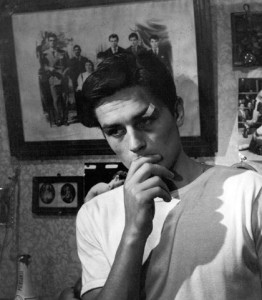 Katina Paxinou plays Rosaria, the strong matriarch who rules the Parondi clan with firm hand and endless demands. When the story begins, she arrives at the Milan train station with her four sons: Simone (Renato Salvatori), Rocco (Alain Delon), Ciro (Max Cartier), and Luca. She is met by the eldest son, Vincenso (Spiros Focas), who arrived earlier and is already established in the city—he has steady employment and is engaged to be married.
Katina Paxinou plays Rosaria, the strong matriarch who rules the Parondi clan with firm hand and endless demands. When the story begins, she arrives at the Milan train station with her four sons: Simone (Renato Salvatori), Rocco (Alain Delon), Ciro (Max Cartier), and Luca. She is met by the eldest son, Vincenso (Spiros Focas), who arrived earlier and is already established in the city—he has steady employment and is engaged to be married.
Vincenso’s efforts to bridge the old ways with the new ones are undermined by the domineering mother, whose old-fashioned, family-dominated view soon cause him to lose his job and threaten his relationship with Ginetta (Claudia Cardinale), his fiancée.
Simone (Salvatori), a handsome but brutish lad goes on to become a boxer, but his promising career is ruined by lack of discipline, male chauvinist attitude, and a destructive affair with Nadia (Annie Girardot), a prostitute who’s herself an immigrant.
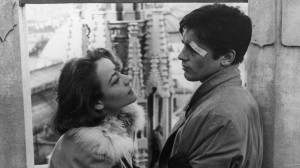 Rocco (Alain Delon) is the kindest and gentlest of the brothers, but he, too, cannot escape the burden of the family and its past. When Rocco falls in love with Nadia, Simone feels angry and threatened. The movie contrasts macho sexuality of animalistic men, who don’t and can’t understand women, with tender romanticism of sensitive men, who feel genuine love and respect for their women.
Rocco (Alain Delon) is the kindest and gentlest of the brothers, but he, too, cannot escape the burden of the family and its past. When Rocco falls in love with Nadia, Simone feels angry and threatened. The movie contrasts macho sexuality of animalistic men, who don’t and can’t understand women, with tender romanticism of sensitive men, who feel genuine love and respect for their women.
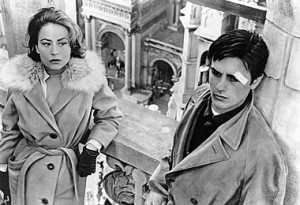 Motivated by vengeance, Simone rapes Nadia, thus reclaiming, as he believes, his “property rights,” while Rocco serving as a witness in the scene of the crime. He then beats Rocco and abandons Nadia, who dies like a Christ figure, arms stretched out, embracing Simone and falling on his knife. (Religious symbolism prevails in other scenes).
Motivated by vengeance, Simone rapes Nadia, thus reclaiming, as he believes, his “property rights,” while Rocco serving as a witness in the scene of the crime. He then beats Rocco and abandons Nadia, who dies like a Christ figure, arms stretched out, embracing Simone and falling on his knife. (Religious symbolism prevails in other scenes).
Rocco’s subservience to his family is expressed in a conversation with Nadia, set atop Milan’s cathedral. He suggests that she must return to Simone, because he really needs her; but Nadia can’t understand that. Later on, Rocco becomes a prizefighter so that he can make enough money to pay for Simone’s debts
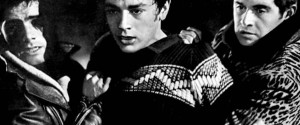 A martyr figure, Rocco is positioned between the brutish and instinctive Simone and Ciro (Max Cartier), a technician in the Alfa Romeo factory, who rejects the traditional code of morality, which, he believes, has already destroyed his older brothers. After the murder, both Rocco and his mother protect Simone from the authorities, but Ciro turns his bother into the police, choosing legal justice over family loyalty.
A martyr figure, Rocco is positioned between the brutish and instinctive Simone and Ciro (Max Cartier), a technician in the Alfa Romeo factory, who rejects the traditional code of morality, which, he believes, has already destroyed his older brothers. After the murder, both Rocco and his mother protect Simone from the authorities, but Ciro turns his bother into the police, choosing legal justice over family loyalty.
Still young and innocent, Luca is a bystander, a boy who can’t understand the issues of code of honor or the real melodrama around him. Visconti stresses the irony of the tale by suggesting that, while Luca is the youngest son who has not really experienced life in the south like his brothers, at the end, he is the only one who wishes to go back to the family’s origins.
 Of the quintet of siblings, Rocco and Simone are the film’s two most fully realized men, with motivations, psychology, and values all their own. In the best noir tradition, their fates become intertwined through their love for the same girl. Some critics have faulted the depiction of Vince, Ciro and Luca, claiming that they are more of abstract figures, or types, than fully developed characters.
Of the quintet of siblings, Rocco and Simone are the film’s two most fully realized men, with motivations, psychology, and values all their own. In the best noir tradition, their fates become intertwined through their love for the same girl. Some critics have faulted the depiction of Vince, Ciro and Luca, claiming that they are more of abstract figures, or types, than fully developed characters.
While Visconti tries to links the melodrama and micro events to larger historical and cultural forces, he is not concerned with unions, strikes, racism, and crime, all inherent and endemic problems in the immigration processes.
Throughout, the director’s point of both view remains ambiguous and ambivalent, as it is in his next film, the masterpiece The Leopard, in 1963, starring Burt Lancaster and Alain Delon. As scholars and critics have observed, there’s constant tension in Visconti’s work between an intellectual belief in the cause of progress and an emotional nostalgia for the past, which inevitably is destroyed by forces of modernization.
Cast
Rocco Parondi (Alain Delon)
Simone Parondi (Renato Salvatori)
Nadia (Annie Girardot)
Rosaria Parondi (Katina Paxinou)
Morini (Roger Hanin)
Boxing impresario (Paolo Stoppa)
Luisa (Suzy Delair)
Ginetta (Claudia Cardinale)
Vincenzo Parondi (Spiros Focas)
Ciro Parondi (Max Cartier)
Crew
Produced by Giuseppe Bordogni
Directed by Luchino Visconti
Screenplay: Visconti, Suso Enrico Medioli, based on the novel The Bridge of Ghisolfa, by Giovanni Testori
Camera: Giuseppe Rotunno
Editor: Mario Serandrei
Music: Nino Rota
Art director: Mario Garbuglia
Costumes: Pietro Tosi
Running time: 177 Minutes
![]()
